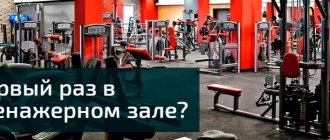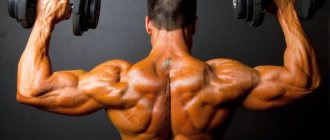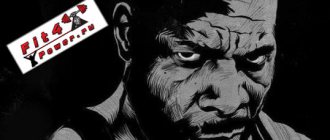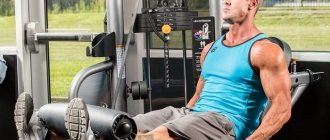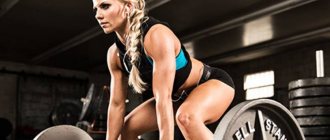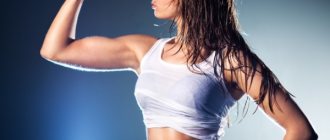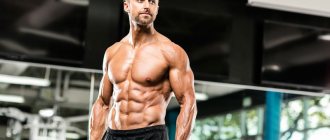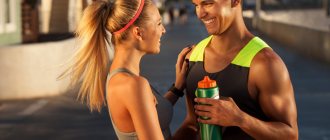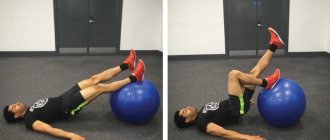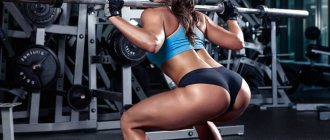The adolescent category includes children aged 10-19 years. This period is divided into early (up to 14 years) and late (from 15 to 19 years) adolescence. It is associated with the active growth and development of the body. “At this time, changes occur both at the physical and mental levels,” says Lyubov Pereverzeva, an expert in the X-Fit children’s fitness department in Russia . — In order for a teenager to develop harmoniously, he needs to follow a sleep schedule, eat a balanced diet and be physically active. Therefore, teenagers need regular physical activity. The determining factor in such activities should be the child’s individual characteristics and personal interests.” The training will be effective, the expert believes, if the student enjoys the training. Sports sections are also good.
Is it possible for a teenager to get pumped up?
With properly selected exercise and nutrition, yes, since somatotropin is responsible for muscle growth in the body, the level of which is usually quite high in adolescents.
“In adolescence, it is enough to simply gain muscle mass and develop several muscle groups at once,” explains Lyubov Pereverzeva. - Levels of the hormone testosterone in boys and growth hormone in both sexes reach their maximum levels between 14 and 18 years of age. Due to the high level of somatotropin, muscles will grow very quickly. But it is important that the load corresponds to age and physique.” Body type will influence the process: asthenics “grow” slower, hypersthenics and normosthenics - faster. It is important to be aware of this and set realistic goals.
Not just hardware
“There is a misconception that muscles can be pumped up only with the help of exercise machines,” notes Korochkin, “but a good effect can be achieved with the help of your own weight.” Such exercises include push-ups, pull-ups, and abdominal exercises. Girls can also go to the gym. But
the load carried out using their own weight and using elastic bands and small weights more physiological This allows girls to become flexible, slim and maintain good muscle tone.
What are the dangers of training for teenagers?
Excessive exercise and overtraining can harm the health of even adult athletes. They are even more dangerous for the child’s body. “With constant excessive physical activity, a teenager’s body does not have time to recover, and its growth may slow down,” notes Lyubov Pereverzeva. “There may also be problems with the cardiovascular system, musculoskeletal system and nervous system.”
What types of sports and exercise can harm your heart? “This applies to competitive sports. With intensive jogging or cycling, focused on aerobic exercise, adolescents are also more likely to develop heart pathologies,” adds Lyubov Pereverzeva.
But working with “hardware” for teenagers is not harmless: with excessive force loads, you can get injured, this also disrupts the natural growth processes.
NEW LIFESTYLE.
The results of training are influenced not only by hardware and technique, but also by your entire lifestyle. A young man eager to find a new body needs to sleep at least 8 hours a day, it is vital to give up bad habits (no smoking, no libations), and start eating right. The best eating style is fractional, 5 times a day at intervals of three hours. You can’t “sandwich” 5 times a day either - you have to maintain a balance of proteins, fats and carbohydrates. You shouldn’t expect results from nutrition while running, because 70-80% of success depends on what a bodybuilder eats. The principle of nutrition is simple: in the morning we load up on slow carbohydrates - these are all kinds of cereals and pasta. Proteins should enter the body in the afternoon, and proteins of animal origin (milk, meat, fish, cottage cheese), as they contain essential amino acids. And you don’t have to strive to “melt all the fat” - lose weight so that the “pack” on your abs becomes noticeable.
Training rules for teenagers
It is best for a coach to create a training program for a teenager, taking into account the initial data and goals of the novice athlete. If this is not yet possible, make a training plan according to these rules:
Start your strength training with exercises without weights. “In the initial stages, children and adolescents should perform exercises with their own body weight in order to master the correct movement technique,” says Lyubov Pereverzeva.
Include basic exercises in your training program that involve several muscle groups - lunges, squats, bending, deadlifts. “When a teenager masters the technique of performing the exercise and can do 8-15 repetitions without errors, the weight load can be gradually increased and work with resistance can be added,” says Lyubov Pereverzeva.
Design a training program to work all major muscle groups. “Strength training in childhood and especially in adolescence should be focused on the development of physical abilities, so it is necessary to involve all important muscle groups. Movements must be performed with full amplitude in order to maintain and develop joint mobility and their functions,” comments the expert.
Increase the load slowly . “The main rule is a very smooth and slow increase in load,” warns Lyubov Pereverzeva. — Do not train using maximum load. Teenagers are in a phase of growth and development, so any overload (with their own weight and weights) can cause injury or create muscle imbalances that will lead to poor posture.”
Be careful when using exercise equipment. First, use light weights to avoid overloading. Secondly, experts do not advise getting too carried away with them in principle. “Gym machines are usually designed for adults and are very often unsuitable for training children, which must meet certain functional requirements,” says Lyubov Pereverzeva.
It is acceptable to perform 1-2 exercises on machines per session, focusing on functional and basic movements with your own weight or weights.
Correctly draw up the “scenario” of the lesson. It should include an introductory part, a main block of exercises and stretching. “A workout always begins with a warm-up, which prepares the body for the upcoming load. Warm-up exercises (joint and general strengthening) should involve the whole body, joints and muscles,” notes Lyubov Pereverzeva.
Examples of warm-ups can be found here.
Then move on to the main block of exercises. “In the main part of the lesson, it is recommended to work on large muscle groups, as an option - combining strength training with cardio (for example: squats, lunges, bending, jumping, running), then - focusing on working with small muscle groups (push-ups, arm curls, bringing the shoulder blades together),” advises Lyubov Pereverzeva.
Experts also recommend using sports equipment during classes: balls of different diameters, balancing platforms, elastic bands, rubber shock absorbers (expanders), TRX loops, dumbbells.
You need to finish your fitness lesson with low-intensity exercises. “At the end of the workout, they perform calmer exercises to reduce stress and restore breathing (for example, stretching and breathing exercises),” adds Lyubov Pereverzeva.
The most important
A teenager can start training on weight training equipment when the period of intensive body growth has ended.
First you need to strengthen the muscles responsible for maintaining the vertical position of the body. Then you can start working using your own body weight and gradually move on to weight training. But only if growth allows, and classes are conducted under the guidance of an experienced instructor. Tags:
- Back
- Exercise equipment
- Power training
- Teenagers
To leave a comment you must be an authorized user
How often should a teenager exercise?
The rule “the more often the better” does not work here. “To achieve long-term positive results, you need to train at least twice a week,” says Lyubov Pereverzeva. “Working out more than four times a week does not bring any additional results.”
Thus, the optimal training load is 2-4 sessions per week. Don't forget to add variety to your fitness classes. “It is important that the workouts include a large number of different exercises, include active recovery phases (vigorous walking, swimming), as well as rest days,” sums up Lyubov Pereverzeva.
You can alternate classes: do one or two workouts with an emphasis on the lower body, another one or two on the upper body.
Follow these tips to create the right exercise program for your teen.
List of exercises
Bent-over dumbbell row
This exercise will allow a teenager to tone his back muscles as effectively as possible. As part of it, the teenager will improve each half of his back. Both left and right. The exercise is performed as follows:
- A teenager needs to stand up straight.
- Your knees need to be slightly bent. The lower back needs to be arched slightly.
- The teenager needs to lower his whole body. So that it makes a 90 degree angle.
- Then, the teenager needs to take dumbbells. Place your elbows so that they look upward.
- Start raising and lowering your elbows. So that the back of the shoulder blades are connected to each other as much as possible.
Pull-ups
Pull-ups are very easy to do. To practice them, a teenager just needs to install a horizontal bar in the room.
You need to perform the exercise as follows:
- The teenager needs to climb onto the horizontal bar. Such a grip, within which the fingers point away from it.
- Your palms should be placed slightly further than your shoulders.
- Then, from the original direction, the teenager needs to slowly climb the horizontal bar. Until he rests his chin on it. After this, the teenager needs to lower himself.
The teenager must perform the exercise slowly. And his thumbs should not be thrown over the horizontal bar. It should hang exclusively on four fingers. Only under this condition does the back swing. In other cases, the biceps swings.
One-arm dumbbell row
This exercise will allow a teenager to literally “finish off” his back. And guaranteed to pump her up. The exercise is isolating. Therefore it can be used at the end of the lesson.
A teenager should do the exercise as follows:
- One of the teenager's two feet should be resting on the ground. The second one needs to be bent at the knee area. And then rest it on the plane.
- The teenager needs to take a dumbbell. Place it on the side on which the straight leg is located.
- The teenager needs to support himself with his other hand. Place your palm slightly lower above the opposite shoulder.
- The teenager's back needs to be arched. So that it is as parallel to the surface as possible. Then, the dumbbell needs to be pulled a little. Up. So that it is placed in line with the teenager's body. This must be done until the teenager’s muscles contract.
- After completing the approach, the teenager needs to change the arm and leg to the opposite one.
Deadlift
Deadlifts will allow a teenager to effectively pump up his back muscles. Moreover, he can do this in a short time. Before starting this task, the teenager must warm up his muscles. The exercise technique is as follows:
- The teenager needs to stand up straight. Arch your back a little.
- Feet should be placed at shoulder level. They need to be bent a little. In the knee area.
- The arms holding the dumbbells should be lowered. They should be placed level directly in front of you.
- The teenager needs to start bending over. Take it slow. Evenly. Until the teenager's body becomes parallel to the surface. Dumbbells should be placed at a level as close to your torso as possible.
- After completing the repetition, the teenager needs to get back to the position from which he started. And do the same steps.
The main problem that causes weight gain in adolescence
The answer is simple, this is the wrong diet of a teenager who does not like home-cooked food, but loves to eat all sorts of goodies, preferring McDonald's, KFC, Burger King, such food and lifestyle if you eat like this every day or every other day, you can suddenly gain excess weight and get fat, hamburgers, cheeseburgers, French fries, sugary drinks, fried wings, and other fast food foods contain a lot of calories, so if you eat only fast food, a child can gain fat and gain weight, his own weight growth depends not only on food consumption, his genetics also affects who he is by type of build - ectomorph - this skinny body type is not prone to gaining pounds compared to the endomorph who is prone to gaining extra pounds quickly! If you ignore the basic nutritional rules of how a teenager should eat, your child may become fat and fat during adolescence!
Fruits and vegetables for breakfast for lunch - dinner
Healthy nutrition for a teenager means not only eating soups and cereals, but also eating fruits and vegetables every day during the day, so that the body feels adequate in vitamins, you must eat fruits and vegetables, for example, fruits are best in the morning, you can eat an apple, a pear , banana, kiwi, grapefruit, and other fruits, vegetables in the morning you don’t always want to eat, so the recommendation for vegetables is to eat them for lunch and dinner in the form of a salad, the best option for soup as a second course instead of porridge. A salad of vegetables, cucumbers, tomatoes, peppers, herbs, dressed with olive oil is the best option.
Will a horizontal bar help?
There is an opinion that exercising on the horizontal bar helps you grow taller.
Growth is 70% genetic and 30% nutritional. No amount of exercise will help you grow a lot.
However, in adults, after prolonged exercise on the horizontal bar, an increase in height by 2-4 centimeters was observed.
This happened when the bones and cartilages of the spine, compressed from an unhealthy lifestyle, returned to their original position due to improved blood circulation.
Static stretching exercises such as yoga and Pilates can also help “rejuvenate” the spine.
However, teenagers need to remember: the horizontal bar forms correct posture.
A straight, dignified back, broad, muscular shoulders and a flexible neck can visually add 5-7 centimeters to your height.
In addition, proper circulation of blood and lymph throughout the body contributes to better distribution of nutrients throughout the cells, which makes nutrition more effective without increasing portions.
In another article, we discussed how to remove your butt.
GYM AND EQUIPMENT.
How to choose a good gym? The recipe is simple: a good coach should work there (and we have already talked about him). There are gyms where people go to hang out - to chat, discuss how their day went. This is nice, but has nothing to do with bodybuilding. If you want to give yourself a new body, look for a gym where people work, sweat, and, as a result, do not distract you from your goals. As for equipment, you also need to pay attention to it. People come to many gyms to work out in flip-flops. A nightmare! For example, when you squat with a barbell in flip-flops, you run the risk of slipping out of your slippers and being crushed by that very barbell. However, there is also no point in buying weightlifting shoes - special shoes for powerlifting. The uniform for sports should initially be a training suit with long pants and long sleeves. Being all long makes it easier to warm up your body during warm-ups and keep you warm throughout your workout. A SUIT FOR ACTIVITIES IN THE GYM SHOULD BE WARM, WITH LONG SLEEVES.
WHAT LOADS SHOULD BE EXCLUDED?
It is advisable to exclude from the training processes those loads that act along the axis of the spine - for example, squats with heavy weights. Heavy weight is the weight of the person himself or more (if a teenager weighs 60 kg, then 60 kg or more is already too much). Another exercise to avoid is the overhead press. Broad shoulders can be pumped up with the help of other exercises: for example, by doing dumbbell raises. Avoid heavy weight deadlifts. Many young people will object - they will say, nonsense! There are guys who, at 16-18 years old, do 250 kg deadlifts and squats. But we must understand that everyone has different data and different heredity. It is better to “undergrow” a couple of centimeters of biceps at a young age than to undermine your heart, tear a tendon, or cause vertebral displacement.

